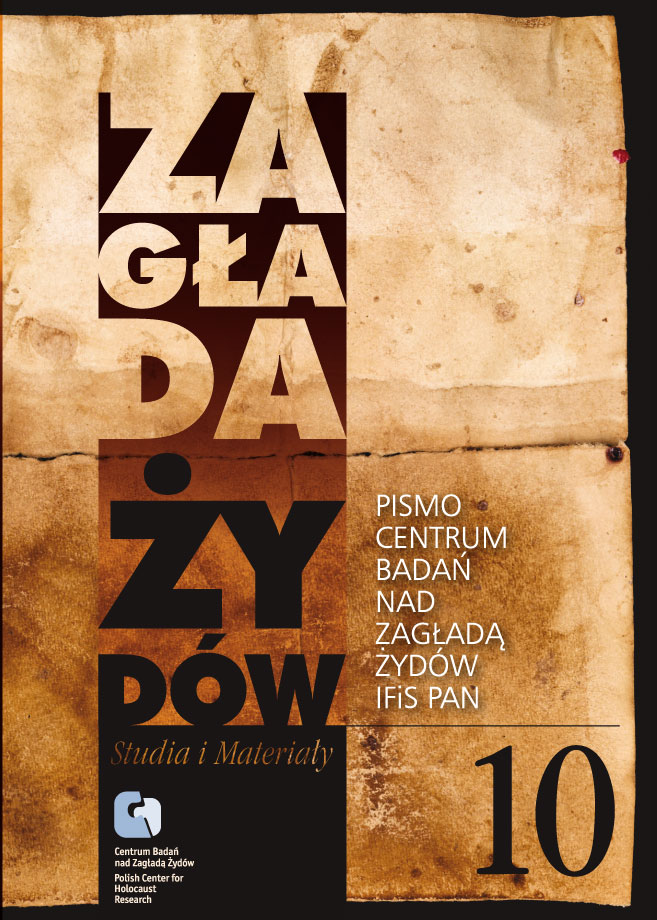Krzesiny i Kreising – między pamiętaniem a pomijaniem. Polskie miasteczko wobec historii, pamięci i rywalizacji w cierpieniu
Zagłada Żydów. Studia i Materiały, Nr 10 (2014), Strony: 443-461
Data zgłoszenia: 2020-10-22Data publikacji: 2014-12-01
 https://doi.org/10.32927/ZZSiM.532
https://doi.org/10.32927/ZZSiM.532
Abstrakt
The area around Krzesiny, located near the city of Poznań, Poland, witnessed several dark events during World War II: Germans oppressed the local population, culminating in a terrorizing action dubbed “akcja krzesińska;” also, a forced labor camp, named “Kreising,” was built near the township, housing mainly Jews. After the war, the suffering in Krzesiny was remembered, but selectively – “akcja” and other forms of Polish suffering were commemorated, while the camp was not. By exploring the “lieux de mémoire” in Krzesiny – dynamics of memory in a small township in Poland – this paper uses localized research to address the issue of gaps in collective memory and commemoration. We briefly look at the relevant history, Polish memory regarding wartime events in Krzesiny, and the postwar dynamics of collective memory. Discussing the latter, we identify a new phenomenon at work, one which we dub “collective disregard” – group neglect of the past of the “Other” that occurs without clear intent. We argue that “collective disregard” is an issue that naturally occurs in the dynamics of memory. By making a deliberate investment in balanced remembrance and commemoration, societies can counter the tendencies of “disregard” and curb the controversies of competitive victimization claims, also called “competitive martyrdom”.
Licencja
Prawa autorskie (c) 2014 Autor & "Zagłada Żydów. Studia i Materiały"

Utwór dostępny jest na licencji Creative Commons Uznanie autorstwa 4.0 Międzynarodowe.
https://creativecommons.org/licenses/by/4.0
Podobne artykuły
- Justyna Kowalska-Leder, „Coraz to nowe żądania, coraz to nowe grymasy” – relacja władzy i podporządkowania między Polakami a Żydami w kryjówkach po aryjskiej stronie , Zagłada Żydów. Studia i Materiały: Nr 12 (2016)
- Piotr Forecki, Anna Zawadzka, The Golden Mean Principle. A Handful of Comments on the Currently Dominant Discourse on ‘Polish-Jewish Relations’ , Zagłada Żydów. Studia i Materiały: Nr Holocaust Studies and Materials (2017)
- Tomasz Żukowski, Jan Borowicz, Pamięć perwersyjna. Pozycje polskiego świadka Zagłady [Tomasz Żukowski] , Zagłada Żydów. Studia i Materiały: Nr 17 (2021)
- Marcin Kula, W pierwszym kręgu. Listy ukrywającego się , Zagłada Żydów. Studia i Materiały: Nr 16 (2020)
- Mateusz Florczak, Saul Friedländer, Dokąd prowadzi pamięć. Moje życie, tłum. Michał Romanek, Kraków: Wydawnictwo Literackie, 2017, 366 s. , Zagłada Żydów. Studia i Materiały: Nr 14 (2018)
- Iwona Kurz, Ten obraz jest trochę straszliwy”. Historia pewnego filmu, czyli naród polski twarzą w twarz z Żydem , Zagłada Żydów. Studia i Materiały: Nr 4 (2008)
- Stephan Lehnstaedt, Niemieccy okupanci w Warszawie a jawność Holokaustu , Zagłada Żydów. Studia i Materiały: Nr 12 (2016)
- Magdalena Semczyszyn, Żydzi w sowieckich oddziałach partyzanckich na północno-wschodnich terenach Drugiej RP 1941–1944 – zarys problematyki , Zagłada Żydów. Studia i Materiały: Nr 17 (2021)
- Filip Gańczak, Prawnicy kontra zbrodniarze Recenzja: Joanna Lubecka, Niemiecki zbrodniarz przed polskim sądem. Krakowskie procesy przed Najwyższym Trybunałem Narodowym, Kraków: IPN i Ośrodek Myśli Politycznej, 2021, 392 s. , Zagłada Żydów. Studia i Materiały: Nr 18 (2022)
- Sabina Giergiel, Transport Kladovo i zagłada Żydów z serbskiego Šabaca , Zagłada Żydów. Studia i Materiały: Nr 15 (2019)
<< < 1 2 3 4 5 6 7 8 9 10 11 12 13 14 15 16 17 18 19 20 21 22 23 24 25 26 27 28 29 30 31 32 > >>
Możesz również Rozpocznij zaawansowane wyszukiwanie podobieństw dla tego artykułu.
 English
English
 Język Polski
Język Polski








